Please allow 7 working days to process before shipping
54 x 1.5" - Nylon Jacquard Woven Belt - Double D-Ring Buckle

Octavia Butler was one of the first African-American science fiction writers, and one of the first women to break the science fiction gender barrier. Butler was born on June 22, 1947, in Pasadena, California. Her difficult life prepared her to write about struggling to survive in hostile dystopias. Her father, a shoeshine man, died when she was seven. Her mother was a maid. Butler would accompany her mother to her cleaning work and recalled her mother entering white people’s houses through back doors.
Consider: Whether you're a human being, an insect, a microbe, or a stone, this verse is true:
All that you touch
You Change.
All that you Change
Changes you.
The only lasting truth
Is Change.
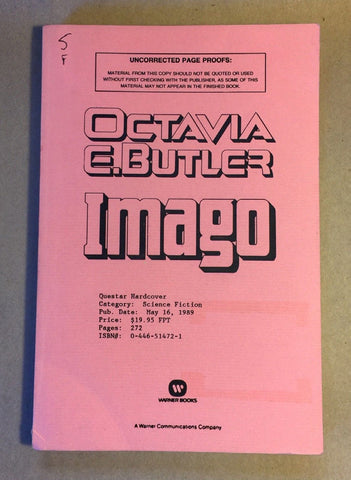
Butler was conspicuously tall for her age and painfully shy. Despite having mild dyslexia, she found escape in books. Her mother would bring home the discarded books of the white families she worked for. Butler’s mother also encouraged her to write and bought her daughter her first typewriter when she was ten years old. Butler recalled her mother remarking that one day she might become a writer, causing Butler her to realize for the first time that it was possible to make a living as an author.
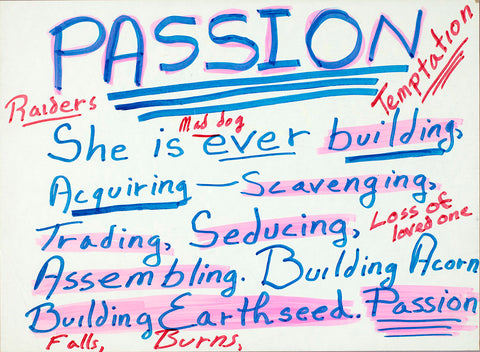
Butler earned an Associate’s degree from Pasadena City College in 1968, and later studied at California State University, Los Angeles. As a student, Ms. Butler became a protégée of the renowned science fiction writer, Harlan Ellison. He encouraged Butler to attend the 6-week Clarion Science Fiction Writers Workshop in Pennsylvania and contributed $100 towards her application fee. Butler’s mother gave Butler the money she had been saving for dental work to pay the rest of the fee. Butler sold her first two stories at the workshop. After her death, the Octavia E. Butler Memorial Scholarship was established by the Carl Brandon Society to provide support to students of color to attend the Clarion Writers Workshop where Butler got her start decades before.

“I began writing about power because I had so little”
Butler began writing stories as a child and soon turned to science fiction. At twelve, she watched the televised version of the film, Devil Girl from Mars, and was convinced she could write a better story. She then drafted a story that would later become the basis for her Patternist novels.

Butler realized that black people were only occasional characters in science fiction stories, and then were usually portrayed as feeble-witted. Many of Butler’s novels featured black women protagonists who are strong, physically and mentally, and intelligent. One of Ms. Butler’s best-known novels, Kindred, tells the story of a modern-day black woman who travels back in time to the antebellum South to save the life of a white, slaveholding ancestor.
We are Earthseed
The life that perceives itself
Changing.
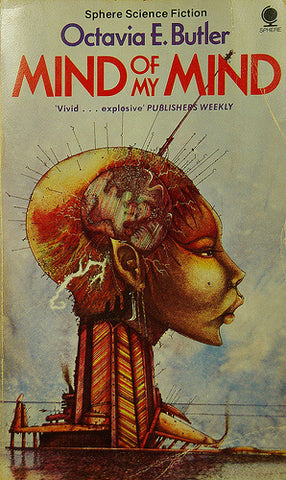
In a lecture at MIT titled “‘The Devil Girl From Mars’: Why I Write Science Fiction,” Butler recalled reading that Robert Heinlein had once delineated three kinds of science fiction stories: “The what-if category; the if-only category; and the if-this-goes-on category.”
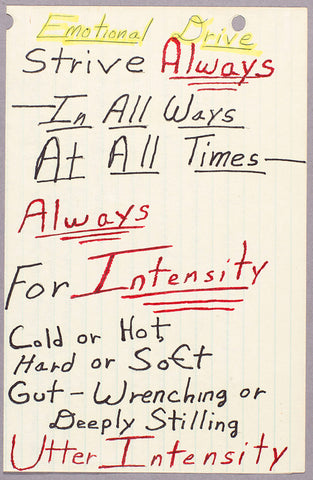
She had mastered the first two categories, and was intrigued by the third. The Parable of the Sower would be a starkly realist novel about where American might carry itself in a few short decades — if this goes on.

To do this, she amalgamated her own memories of growing up in the racially integrated Pasadena of the 1950s with contemporaneous news reports about rises in global warming, racism, violence, prison populations, and mega-corporations. In this way, she created the shattered America described by Lauren Oya Olamina, a black fifteen-year-old with “hyperempathy” living in a walled-up town outside of LA in 2024.
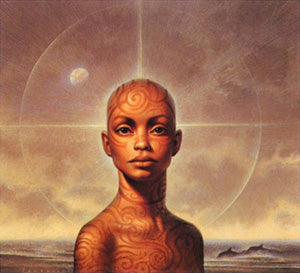
Told through Lauren’s diaries, the novel envisions the crises facing America thirty-some years later with eerie accuracy. Clean water is getting scarcer. Whole towns are being privatized by individual companies. Literacy is deteriorating—and, oh yeah, there’s a charismatic President promising to make the country great again.
The Parable of the Sower was published in 1993 and became a New York Times Notable Book the following year. Already a Hugo and Nebula award-winning writer, Butler soon became the first science fiction writer to ever receive the MacArthur Foundation “Genius Grant.” She said she hoped the prize, which at the time was $295,000, would help her to complete her work on the trilogy.
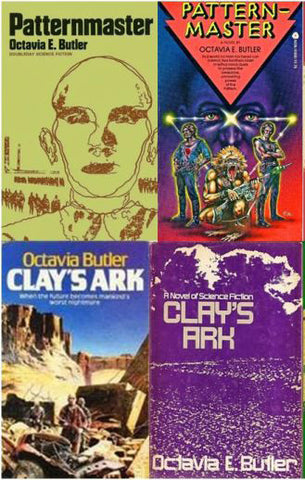
A year later she published a sequel, The Parable of the Talents, in which a religion based on Lauren’s diaries, called “Earthseed,” struggles against Christian fundamentalism. At the time, Butler spoke in interviews about her ideas for the third book, The Parable of the Trickster, in which adherents of Earthseed would attempt to build a new society on another planet.
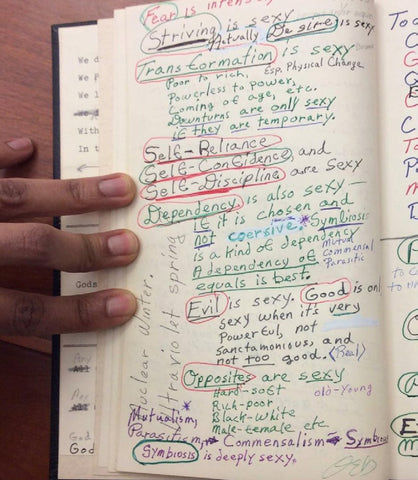
But, struggling for years with depression and writer’s block, Butler would not finish the trilogy as she planned, though she would complete several new stories and a novel, Fledgling, about a race of vampires trying to co-exist with humans.

In 2006, Butler died of a stroke outside her home in Lake Forest Park, Washington. Her many papers now reside at the Huntington, a private library in San Marino, California. Curator Natalie Russell describes the collection as including “8,000 manuscripts, letters and photographs and an additional 80 boxes of ephemera.” On display there now are numerous treasures, including working manuscript pages from The Parable of the Sower covered in her brightly colored notes: “More Sharing; More Sickness; More Death; More Racism; More Hispanics; More High Tech.”

There are the beautiful, bold affirmations which she wrote to frame her motives for writing: “Tell Stories Filled With Facts. Make People Touch and Taste and KNOW. Make People FEEL! FEEL! FEEL!” On one page of her journals she visualized the success that she desired: “I am a Bestselling Writer. I write Bestselling Books And Excellent Short Stories. Both Books and Short Stories win prizes and awards.” But what is not on public view are the drafts — the things she had hoped to write someday and never did, including The Parable of the Trickster.
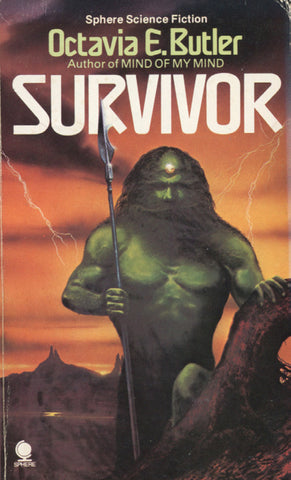
Scholar Gerry Canavan described getting a look at that work-in-progress for the LA Review of Books in 2014:
“Last December I had the improbable privilege to be the very first scholar to open the boxes at the Huntington that contain what Butler had written of Trickster before her death. What I found were dozens upon dozens of false starts for the novel, some petering out after twenty or thirty pages, others after just two or three; this cycle of narrative failure is recorded over hundreds of pages of discarded drafts. Frustrated by writer’s block, frustrated by blood pressure medication that she felt inhibited her creativity and vitality, and frustrated by the sense that she had no story for Trickster, only a “situation,” Butler started and stopped the novel over and over again from 1989 until her death, never getting far from the beginning.”
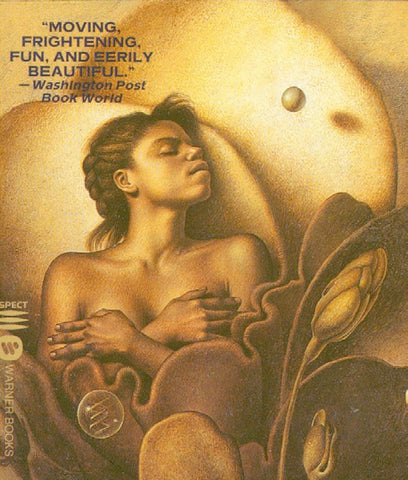
The novel’s many abandoned openings revolve around another woman, Imara, living on an Earthseed colony in the future on a planet called “Bow,” far from Earth. It is not the heaven that was hoped for, but “gray, dank, and utterly miserable.” The people of Bow cannot return to Earth and are immeasurably homesick. Butler wrote in a note, “Think of our homesickness as a phantom-limb pain — a somehow neurologically incomplete amputation. Think of problems with the new world as graft-versus-host disease — a mutual attempt at rejection.”
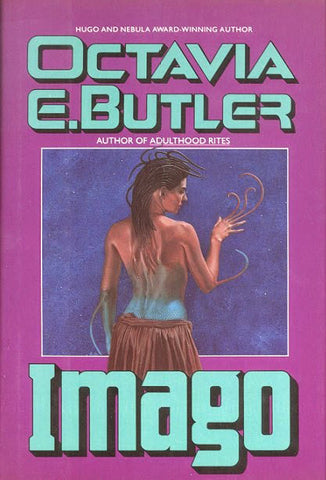
From there Butler became hopelessly blocked — though not exactly in the commonly-held image of writers’ block, of staring day after day at a blank page, lacking inspiration and confidence. In fact, as Canavan describes, her “dozens upon dozens” of drafts represent a wide range of ambitious ideas.
In some versions, the colonists struggle with a creeping blindness. In others, they develop a terrible telepathy. There are versions where Imara must solve a murder and versions where Imara herself is murdered but becomes a ghost. “Sometimes Imara is an Earthseed skeptic; other times she is a true believer; sometimes she is, like Olamina, a hyperempath; still other times the cure for ‘sharing’ has been discovered in the form of an easy, noninvasive pill,” writes Canavan. “Sometimes Bow is inhabited by small animals, other times by dinosaur-like giant sauropods, and still other times by just moss and lichens; sometimes the colonists seem to encounter intelligent aliens who might be real, but might just be tokens of their escalating collective madness; and on and on and on.”

Canavan reveals that Butler hoped for this book to serve not as the last in a trilogy, but as the middle of a seven-part series. Trickster was to be the first of four new novels about life on Bow and the colonists’ struggle to build a better humanity. He writes that the colonists “can choose: either live together, work together, struggle together, and pray together, or else hoard food alone, scheme alone, lose their minds alone, breakdown and die and murder each other alone.”

Four more books. That would be how long it would take, in Butler’s estimation, for the human beings of the future to move past their homesickness, their biology, and their history and truly become capable of working towards a common decency. She saw hope, but only a long way off.